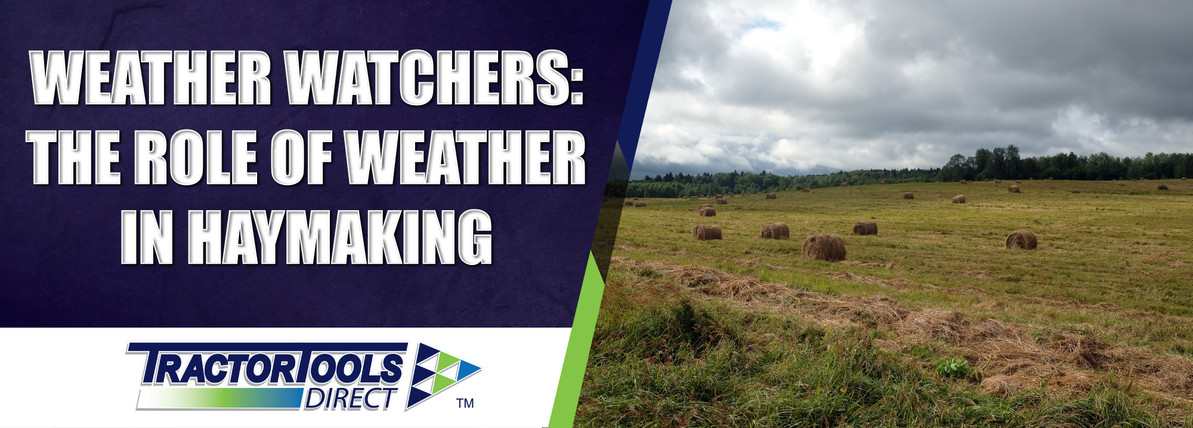Weather Watchers: The Role of Weather in Haymaking
When it comes to producing high-quality hay, few factors are more critical—or more unpredictable—than the weather. Rain, temperature, humidity, and wind all directly impact how effectively hay dries in the field. For small-acreage farmers using compact equipment, understanding and planning around weather conditions is essential to protecting your crop and maximizing forage quality.
Rain is one of the biggest threats once hay is cut. Moisture during the curing stage halts the drying process and creates ideal conditions for mold, fermentation, and spoilage. In nutrient-rich crops like alfalfa, rain can cause leaf loss, significantly reducing feed value. Even a quick shower can delay drying by a full day or more. Worse still, repeated wetting and drying can cause baled hay to heat internally—creating both a quality issue and a fire hazard.
Finding a Hay-Making Weather Window
The best conditions for haymaking are 3–5 days of warm, sunny, and dry weather. This gives hay time to properly cure before baling. Always monitor the extended forecast, and don’t be tempted to cut just before expected rainfall. Timing your cut with the right weather window is just as important as cutting at the correct growth stage. For efficient cutting, consider using one of our compact drum mowers. To learn more about our drum mowers visit A Drum Mower is a Hay Mower.
Caught in an uncertain forecast? Use a hay tedder to spread and fluff hay, accelerating dry-down. Rakes can help turn and expose wet areas to sunlight and airflow. But if drying time looks too short, it may be better to delay cutting and avoid risking the crop—or your equipment in muddy fields.
Factors in Haymaking: Humidity, Temperature, Wind
Even without rain, high humidity can significantly slow drying. Hay cures fastest in low humidity with good airflow. Plan to rake and bale during late morning to mid afternoon, after dew has lifted and before it settles again at dusk.
Temperature also plays a major role. While warm weather helps, excessive heat can lead to uneven drying or scorched leaves. Cool nights often bring dew, essentially restarting the drying process each day.
Finally, wind is your quiet ally. A steady breeze helps remove surface moisture and can shave up to a day off drying time—especially in dense windrows.
Final Thoughts: Predicting The Unpredictable is Pertinent
By paying close attention to weather patterns–and using the right tools like mowers, tedders, rakes, and compact balers–, you’ll improve forage quality, reduce losses, and make haymaking a smoother, more successful process.
To learn more about our hay tools visit www.tractortoolsdirect.com or give us a call at 260-BALE-HAY. We’ll be happy to help!
FAQs for Haymaking: Weather Edition
What is the best weather for cutting hay?
The best weather for cutting hay is 3-5 days of dry, sunny weather with low humidity and steady wind. THis allows hay to properly cure before baling. Avoid cutting before rain is expected, as moisture can lead to mold, spoilage, and nutrient loss.
How does rain affect hay after it’s been cut?
Rain during the drying process can re-wet hay, delaying curing and increasing the risk of mold and fermentation. It also causes leaf loss in crops like alfalfa, reducing the quality of your forage. Even light rain can set back drying by a full day.
What equipment helps hay dry faster in poor weather conditions?
Using hay tedders helps fluff and spread the hay to accelerate drying. Rakes can also help turn the hay and expose wet layers to sunlight. These tools are essential when you’re racing the weather.
Can I cut hay if rain is in the forecast?
It’s usually best to wait for a clear weather window. Cutting before expected rain can result in poor curing, mold, and lower forage quality. If you’re unsure, monitor the forecast and prepare to use tools like tedders or rakes to speed up drying.
What role does humidity play in drying hay?
High humidity slows the drying process significantly. Hay needs low humidity and good airflow to dry properly. Plan to rake or bale during the first part of the day, typically late morning to early afternoon, when dew has evaporated.
What temperature is best for drying hay?
Warm temperatures help, but moderate heat with low humidity is ideal. Excessive heat can scorch leaves and dry hay unevenly, while cooler nights can cause dew formation, delaying the drying process. Balance and timing are key.
Recent Posts
-
How to Winterize Your Tractor: Essential Maintenance Tips to Protect Your Investment
Farm equipment is one of the most valuable investments a farmer can make. At Tractor Tools Direc …Dec 1st 2025 -
Farm Tax ID Explained: Benefits, Eligibility, and How to Apply
As the end of the financial year approaches, it's a great time for small farmer operators to rev …Nov 12th 2025 -
Rototillers vs. Power Harrows: Which Tool is Best for Your Soil?
Fall might seem like an odd time to talk about planting, but there really is no better time to t …Oct 27th 2025




